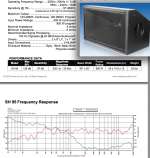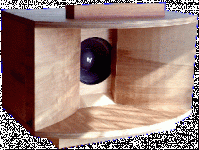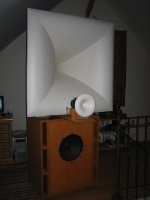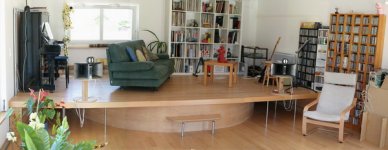None, the length is the same as if it were a standard conical horn.
I use the Paraline because in a line array PA the HF must have very narrow dispersion to avoid interference patterns from adjacent horns.
The Paraline is great in that regard, but it imparts a ragged frequency response.
I would not consider it for single driver use, and if you look at the DSL product line, they do not use Paralines in any single driver applications either.
Not to put a damper on your project, but an Alpha 8 in a small sealed or ported box can do 110 dB with just 50 watts, and have smoother response than in any horn.
OSHA limits exposure of 110 dBA Slow to only half an hour a day, longer than that statistically will cause hearing damage.
A small horn can give you another 3-6 dB on axis, but do you actually listen loud enough to warrant the extra real estate it takes up?
Thanks for your insight Art, and for reigning me in 🙂 I must admit, I'm a little bit disappointed that I can't really make proper use of any of these great technologies for the scenario I have at the moment.
I noticed in the Square Pegs thread that you'd answered in regards to a Synergy horn being the most suitable application. I like Bwaslo's design, but alas I only have the drivers I have.
Loudness isn't the goal for me...it's more that I want to hear the detail in recordings which I've only found so far in systems with high sensitivity.
It looks like the symmetry of 4 woofers + 1 tweeter (dome or compression driver) is the given approach for the Synergy horn. This might be a completely whacky idea, but could I make a horn with just one woofer and compression driver tweeter?
Looking at WinISD, a closed box for the Alpha 8 is 32L. It almost seems too easy, but if it ends up that I can't do anything else, I suppose that would be the route I'll have to take!
This might be a completely whacky idea, but could I make a horn with just one woofer and compression driver tweeter?
Sure you can, straight horn for the alpha 8, straight horn for the compression driver. If the horn for the midbass gets to big, make it smaller / crossover a bit higher to the subs. ( ot think about later adding a folded horn sub 🙂 upto 200 - 300 Hz)
Question related to horns. If you would want a horn three way system with wide dispersion, no or as little as possible honk, highest sound quality (low distortion/ homs etc horns) and close as can get center to center distance. Iwata for mid and high is the only way?
Last edited:
Phenoholoic Anonymus, that's definitely a horn design that I've not looked into. It's an interesting design, and I suppose that when I first saw it i thought the construction precision required might be too much for me.
However, it seems like there are a lot of designs for the Iwata horns online, so it's worth a try! Is there a calculator for them?
However, it seems like there are a lot of designs for the Iwata horns online, so it's worth a try! Is there a calculator for them?
As far as I have seen, no DSL Synergy horn uses 4 woofers + 1 tweeter, though some use four mid drivers and two woofers.Loudness isn't the goal for me...it's more that I want to hear the detail in recordings which I've only found so far in systems with high sensitivity.
It looks like the symmetry of 4 woofers + 1 tweeter (dome or compression driver) is the given approach for the Synergy horn. This might be a completely whacky idea, but could I make a horn with just one woofer and compression driver tweeter?
One 8" driver in a Synergy would probably have asymmetrical upper mid response, but two 8" and a 1" work fine, as the little DSL SH95 clearly demonstrates.
A similar cabinet using your components would be a very easy build compared to what you have been contemplating, and have a virtual single point source which is not possible with any two separate radiating sources.
The virtual point source means you can listen as close to the horn as you like (no off axis near field lobing), the inverse distance (+6 dB for halving distance) can more than make up for the slight sensitivity loss of a larger exponential horn.
Phase response in the crossover region is not quite as smooth as some of the others in the DSL lineup, but with DSP you could get the phase and frequency response smoother than any of the passive DSL offerings.
Bass reflex porting (if you desired to increase the output below 300 Hz) would be the same for one speaker as two, you could start with one 8" and the HF driver, then add a second 8 later if the dispersion of one bothers you.
I'd suggest cutting the holes and the surround recess for both 8" and then putting in a removable back sealer plate to cover the unused holes.
Art
Attachments
Yes, JMLC made an spreadsheet for Iwata horns, Melaudio France hosts it:
http://forums.melaudia.net/attachment.php?aid=2310
As far as i can see, you can make them in 2 planes or go really funky 🙂

I think, these horns really 100% absolutely positively need an extra big roundover 🙂
http://forums.melaudia.net/attachment.php?aid=2310
As far as i can see, you can make them in 2 planes or go really funky 🙂
An externally hosted image should be here but it was not working when we last tested it.

I think, these horns really 100% absolutely positively need an extra big roundover 🙂
Last edited:
Conical expansion horns offers all the desirable attributes of the Iwata/LaCleach types of horns, and constant directivity determined by the wall angle.Question related to horns. If you would want a horn three way system with wide dispersion, no or as little as possible honk, highest sound quality (low distortion/ homs etc horns) and close as can get center to center distance. Iwata for mid and high is the only way?
The only drawback is reduced LF output for a given mouth size.
Thanks Art,
The drawback afaik for conical would be very little driver loading. (reducing excursion). The enormous sized + would be easier construction.
The drawback afaik for conical would be very little driver loading. (reducing excursion). The enormous sized + would be easier construction.
Constant directivity is an enormous plus for me, but some people prefer narrowing HF dispersion which can compensate for the falling HF driver response on axis.Thanks Art,
The drawback afaik for conical would be very little driver loading. (reducing excursion). The enormous sized + would be easier construction.
Response can easily be corrected with EQ, but dispersion can't.
somewhere here there is a thread showing how to make a waveguide mold for 8" coax
I only remember he is from Finland, but that's all right now
Hello, my project has been on hold for a while for the reason I haven't got the transducers yet. Now they are being shipped, and my project continues in the next week.
Here's the waveguide thread.
Last edited:
So if i understand pattern flip correctly, it would look like what is seen on the right sonogram? My apologies for being such an thread intruder unaHm!


Last edited:
thank you 🙂
Hello, my project has been on hold for a while for the reason I haven't got the transducers yet. Now they are being shipped, and my project continues in the next week.
Here's the waveguide thread.
somewhere here there is a thread showing how to make a waveguide mold for 8" coax
I only remember he is from Finland, but that's all right now
Yes, but JMLC disagreed:So if i understand pattern flip correctly, it would look like what is seen on the right sonogram?
http://www.diyaudio.com/forums/multi-way/140190-jean-michel-lecleach-horns-165.html
Unfortunately, he died not too long after that discussion.
Thanks! Interesting link, indeed very sad JMLC passed away. Now we will never know how his horns might even further evolve. These sonograms sure help a lot to visualize complex things!
Last edited:
Off axis response of mid and HF horns (and even the upper range of bass horns) is a critical performance aspect, yet many manufactures only provide a single on axis chart, often because the off axis response is terrible.Thanks! Interesting link, indeed very sad JMLC passed away. These sonograms sure help a lot to visualize complex things!
Without seeing the rest of the polar response, the on axis response alone tells very little.
Ok, after a bit of fiddling with Jean-Michel's spreadsheet, I've ended up with this:

It doesn't really look like an Iwata horn, though I did use the expansion coefficient of 0.5, as he had described in one of his threads.
In the spreadsheet I'd specified 4 sides, so maybe that's why it looks 'different'. Should I have done two?

It doesn't really look like an Iwata horn, though I did use the expansion coefficient of 0.5, as he had described in one of his threads.
In the spreadsheet I'd specified 4 sides, so maybe that's why it looks 'different'. Should I have done two?
Hmm, no free lunch, closer center to center spacing with an Iwata or conical pushes patternflip up in freq. Back to square/ round one.
The Iwata look similar to a round exponential horn that has been stepped on.It doesn't really look like an Iwata horn, though I did use the expansion coefficient of 0.5, as he had described in one of his threads.
In the spreadsheet I'd specified 4 sides, so maybe that's why it looks 'different'. Should I have done two?
This one looks like a beamy exponential horn with a diffraction reducing roundover on the end.
Is a two sided horn similar to the sound of one hand clapping ?
What do you think about post #344?
Last edited:
sorry if it is somewhat OT, but it just struck me that the big lecleach midhorn looks better before enlarging the pic 

Attachments
The Iwata look similar to a round exponential horn that has been stepped on.
This one looks like a beamy exponential horn with a diffraction reducing roundover on the end.
Is a two sided horn similar to the sound of one hand clapping ?
What do you think about post #344?
Yes, my one-handed clap, although audible, isn't that great 😉
I've been looking at the Iwata horn designs here, and like the methods of construction. However, they only go down to 250Hz.
I had to read post #344 a number of times before I understood 🙂 It's simple enough, but I was just looking at it from the wrong angle.
So, the concept is to have a single Alpha 8, using the power from the rear of the cone to a port at the front of the horn, with the compression driver at the end for the treble?
Something like this?

Red = Eminence Alpha 8
Green = Pyle PDS521
Blue = Reflex 'port'
- Status
- Not open for further replies.
- Home
- Loudspeakers
- Multi-Way
- Midbass horn



